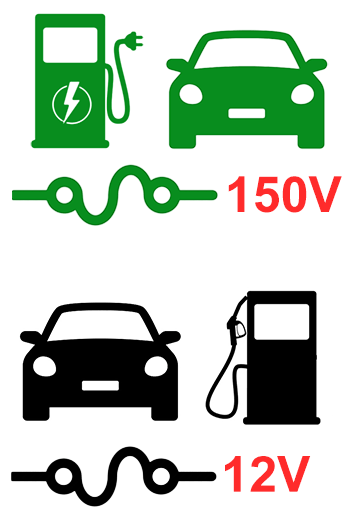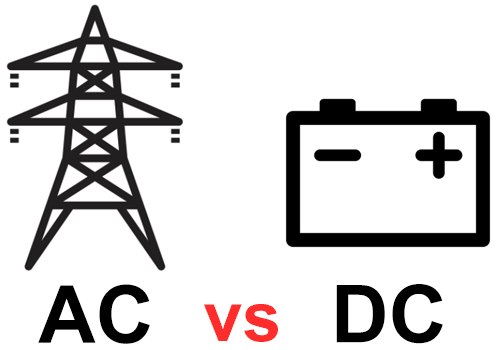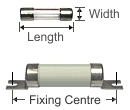Understanding Electric Vehicle Fuse Selection.
Electric Vehicle Circuit Protection Requirements
The arrival of Electric Vehicles (EV) & Hybrid Electric Vehicles (HEV) brings a new set of design challenges for electrical fuses.
Fuse products for EV/HEV applications are relatively new in the industry.
There are many aspects of an EV/HEV that require protection from electrical overload or short circuits.
Components requiring protection include batteries, power conversion equipment, contactors, cabling and other auxiliary circuits.
Traditional automotive lead-acid batteries are typically rated 12Vdc, 24Vdc or 42Vdc. However batteries used in electric vehicles are
moving to Lithium-Ion which can range from 150Vdc to 800Vdc. Higher system voltages increase the power of the vehicle, improve the driving range
and reduce charging times. In EV applications, electrical fault conditions can reach as high as 950Vdc, so electrical components
must be able to operate safely at these high voltages. Fuse links must be rated for operation at these maximum voltage levels to ensure
they are safely able to interrupt fault currents.
Shop our Range of EV Fuses

The Challenges of Protecting DC Voltage Circuits
DC faults are notoriously more difficult to clear than AC faults. This is because the sinusoidal nature of alternating current assists with the extinguishing of arcs inside the fuse during operation. Unfortuantely, this is not the case when a fuse is used in DC voltages as the voltage remains constant. It is not possible to define one DC voltage rating to cover considerable varying fault conditions, so specialised fuse links and specific application testing become the only option under DC conditions. When designing DC fuses to protect batteries, the state of the battery during a fault will affect the short-circuit level, which can often be very low.

EV/HEV Fuse Standards
Over the years, the behaviour of fuse links in specific applications has been well tested
and specific standards created to ensure the reliability and safety of fuse links in this applications.
eg. industrial fuse links designed and tested to known standards IEC 60269 and UL 248.
EV/HEV are relatively new applications and have electrical circuits operating in these vehicles experience
conditions that are often outside any researched behaviours and current standards. Therefore an in-depth understanding of
the environmental parameters and typical drive cycle profile is key to selecting a suitable
fuse link for such a demanding environment. Fuse manufacturers are still actively working with EV/HEV manufacturers to
develop and improve circuit protection products for this rapidly evolving industry.
As of 2016 there are no certification standards or industrial regulations defined for Electric Vehicles.
However the following industry and quality management standards are referenced by EV & HEV fuse manufacturers for fuse links below 500Vdc;
- AECQ200
- JASO D622 - Japan
- SAE J2781
- ISO 8820-1
- ISO 8820-8

Considerations for EV Fuse Selection
1. Basic Current Selection.
When selecting a fuse, the first step is to calculate the actual RMS steady-state load current passing through the fuse link, which is less than or equal to calculated maximum
permissable load. Exclude the influence of overload and cyclic loading at this stage.
2. Temperature Derating
Fuse current ratings are based on an ambient temperature of approximately 20 degress celcius.
Ambient temperatures above this level will reduce the current carrying capability of the fuse.
This is because the fuse is unable to dissipate heat as effectively in higher ambient temperatures.
EV fuses are often located in areas where temperatures can reach a maximum of 60 to 80 degress Celcius.
3. Thermal Connection Derating
Fuses are typically connected to cables and metal fixings such as studs or busbars. These connections conduct heat
away from the fuse which allows it to run cooler. The cross sectional area of these conductors must be considered when
selecting a fuse. Weight and space reductions in vehicle design may reduce the cross sectional area and therefore
the fuse is operating at higher temperatures.
4. Cooling Air Adjustment
Fuse links mounted in a well vented space and possibly air cooled by a fan will dissipate heat faster and this will also affect the
selection of fuse current rating. Lower current ratings are required for well ventilated areas.
5. High Altitude Derating
Higher altitudes provide LESS air cooling for fuses due to the reduced air density. Should the EV be operated above 2000m, a thermal
derating factor must be applied to the continuous rating of the fuse.
6. Enclosure Derating
Should the fuse be located in a small enclosure with no ventilation, it will run hotter which will affect the rating selection for the fuse.
7. Cyclic Loading
Regular or irregular variations of load current can cause premature fatigue in a fuse link which would lead to nusiance blowing.
To avoid this situation, calculations need to be made to ensure an appropriate safety margin for the fuse link.
EV/HEV fuses experience cyclic conditions during normal operation. When designing fuses for EV/HEV vehicles, the manufacturer
will usually provide a variety of drive profiles to simulate typical driving conditions. These profiles can be used to
select the correct current rating of the fuse.
8. Influence of Overloads
Once a fuse current ratings has been selected in accordance with steps 1 to 7, next we must check the influence of short term overloads
on the fuse. In EV applications, the overload condition should not come within 50% of the current required to melt the fuse in that time.
9. Coordinating Fuse with Relays & Other Protection Components
Fuses in electric vehicles are often required to coordinate with a relay or circuit breaker to cover all fault conditions; both low and
high short circuit currents. The fuse will commonly handle short circuits, whilst the relay will handle low overload currents. As such all these
circuit protection components need to operate in a coordinated manner during a fault scenario. This can prove quite challenging for both fuse and
vehicle manufacturers.
10. Fuse Selection
Once we have established the current rating for the fuse, we still need to ensure the fuse has the required maximum DC voltage rating and
it's physical size and mounting style is suitable for the application.
To learn more about EV fuse selection, read the
Eaton Bussmann EV Fuse Selection Guide.
Shop our range of EV Fuses
We sell fuses are specifically designed to protect electrical circuits in elecric vehicles.
View our range of Bussmann and Adler electric vehicle fuses.





